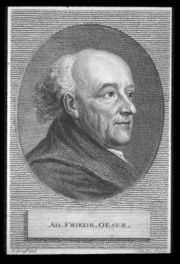
Adam Friedrich Oeser
Encyclopedia

Germany
Germany , officially the Federal Republic of Germany , is a federal parliamentary republic in Europe. The country consists of 16 states while the capital and largest city is Berlin. Germany covers an area of 357,021 km2 and has a largely temperate seasonal climate...
etcher, painter
Painting
Painting is the practice of applying paint, pigment, color or other medium to a surface . The application of the medium is commonly applied to the base with a brush but other objects can be used. In art, the term painting describes both the act and the result of the action. However, painting is...
and sculptor.
Biography
Oeser worked and studied in Pressburg (student of Georg Raphael Donner in sculpture) and ViennaVienna
Vienna is the capital and largest city of the Republic of Austria and one of the nine states of Austria. Vienna is Austria's primary city, with a population of about 1.723 million , and is by far the largest city in Austria, as well as its cultural, economic, and political centre...
at the Vienna Academy (painting). He went to Dresden
Dresden
Dresden is the capital city of the Free State of Saxony in Germany. It is situated in a valley on the River Elbe, near the Czech border. The Dresden conurbation is part of the Saxon Triangle metropolitan area....
in Saxony
Saxony
The Free State of Saxony is a landlocked state of Germany, contingent with Brandenburg, Saxony Anhalt, Thuringia, Bavaria, the Czech Republic and Poland. It is the tenth-largest German state in area, with of Germany's sixteen states....
in 1739, where he created portraits, scenes for the Royal Opera, and mural paintings in Schloss Hubertusburg
Hubertusburg
thumb|right|300px|Hubertusburg, WermsdorfHubertusburg is a palace in Saxony, in the village of Wermsdorf and midway 6 m. between the towns Oschatz and Grimma. It was built in 1721-1724 by Frederick Augustus I, Elector of Saxony and King of Poland, and is given to his son Augustus III in 1724, as a...
(1749). In 1756 Count Heinrich von Bünau
Heinrich von Bünau
Count Heinrich von Bünau was a statesman and historian from the Kingdom of Saxony, now part of Germany.-Life:Born in Weissenfels, he was the son of the Chancellor of the Elector of Saxony, Heinrich von Bünau , who was created an Imperial Count on 24 March 1742...
commissioned him to decorate the newly-built Schloss Dahlen.
Oeser removed to Leipzig in 1759. Appointed director of the newly founded Academy there in 1764, he zealously opposed mannerism
Mannerism
Mannerism is a period of European art that emerged from the later years of the Italian High Renaissance around 1520. It lasted until about 1580 in Italy, when a more Baroque style began to replace it, but Northern Mannerism continued into the early 17th century throughout much of Europe...
in art. He was a stout champion of Winckelmann's
Johann Joachim Winckelmann
Johann Joachim Winckelmann was a German art historian and archaeologist. He was a pioneering Hellenist who first articulated the difference between Greek, Greco-Roman and Roman art...
advocacy of reform on antique lines. He also befriended Winckelmann, who lived with him and his family in 1754/55.
Oeser's chief importance was as a teacher. He was the drawing teacher of Johann Wolfgang Goethe, with whom he kept up friendly relations afterwards at Weimar
Weimar
Weimar is a city in Germany famous for its cultural heritage. It is located in the federal state of Thuringia , north of the Thüringer Wald, east of Erfurt, and southwest of Halle and Leipzig. Its current population is approximately 65,000. The oldest record of the city dates from the year 899...
. Besides a number of decorative works, mostly ceilings, he painted mythological and religious canvases and portraits, among the best being: "The Artist's Children" (1766, Dresden Gallery), "Marriage at Cana" (1777) and four others in Leipzig Museum, and "The Painter's Studio" (Weimar Museum). His best effort in sculpture is the monument of Elector Frederick Augustus
Augustus II the Strong
Frederick Augustus I or Augustus II the Strong was Elector of Saxony and King of Poland and Grand Duke of Lithuania ....
(1780) on the Königsplatz in Leipzig, which he created together with his student and architect Johann Carl Friedrich Dauthe
Johann Carl Friedrich Dauthe
Johann Carl Friedrich Dauthe was a German architect and etcher who specialised in the Neo-Classical style.Dauthe was born in Leipzig and educated by Adam Friedrich Oeser...
.


